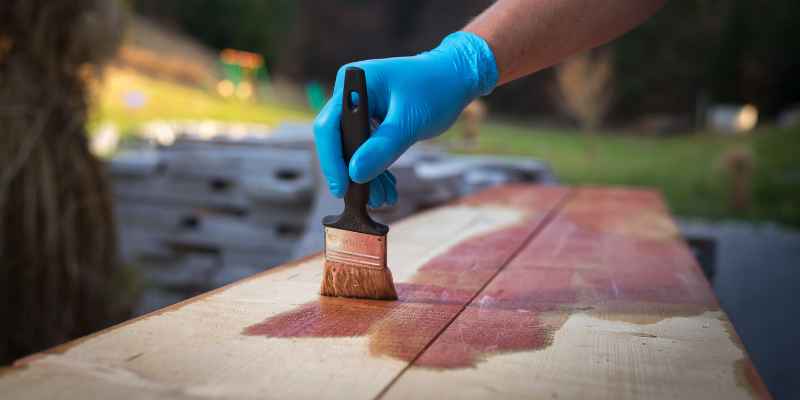Yes, you can stain mango wood. It absorbs stains well, enhancing its natural beauty.
Mango wood is a popular choice for furniture and decor due to its durability and unique grain patterns. Staining can elevate its aesthetic appeal, allowing you to match your wood pieces with your home’s interior design. This hardwood offers a rich, warm tone that can be enhanced with various stain colors.
Understanding how to properly stain mango wood can help you achieve the desired finish, whether you want a dark, dramatic look or a light, airy appearance. With the right preparation and technique, you can transform mango wood into a stunning centerpiece in your living space. Explore the benefits and methods of staining this beautiful wood to create your perfect atmosphere.
Introduction To Mango Wood
Mango wood is a popular choice for many furniture makers. It is known for its beautiful grain and rich colors. This wood is also very durable and strong.
Many people appreciate the unique patterns in mango wood. It can be easily shaped and polished. This makes it perfect for crafting furniture.
Due to its natural resistance to moisture, mango wood is great for humid areas. It is also eco-friendly, as it comes from sustainable sources. These qualities make mango wood a favorite among buyers.
Staining mango wood can enhance its beauty. A good stain can bring out the grain. Many colors are available to match any decor.

Pre-stain Preparation
Start by cleaning the surface of the mango wood. Use a soft cloth to wipe away dust. For tough spots, dampen the cloth slightly. Allow the wood to dry completely before proceeding.
Next, sanding for smoothness is essential. Use fine-grit sandpaper to smooth the surface. Sand in the direction of the grain to avoid scratches. This helps the stain to apply evenly. After sanding, remove any dust with a vacuum or cloth. A clean surface ensures better results.
Choosing The Right Stain
Choosing the right stain for mango wood can enhance its beauty. Several types of stains work well. Here are some options:
| Type of Stain | Description |
|---|---|
| Oil-Based Stain | Penetrates deeply, highlighting the wood’s grain. |
| Water-Based Stain | Dries quickly and has low odor. |
| Gel Stain | Thick consistency that clings to the wood surface. |
Color choices matter. Light stains can brighten the wood. Dark stains create a rich, dramatic effect. Consider the overall look you want to achieve. Test a small area first to see how the wood reacts.
Staining Techniques
Staining mango wood can enhance its natural beauty. Two common methods are brush and rag application. Each method has its own benefits.
Brush application allows for a precise finish. It works well on larger surfaces. Use a high-quality brush to avoid streaks.
Rag application offers a more controlled and natural look. This method is great for small projects. It helps to create an even finish.
For even coating, consider these tips:
- Always test on a small area first.
- Apply in thin layers to avoid drips.
- Work with the grain of the wood.
- Allow sufficient drying time between coats.
The Staining Process
Staining mango wood requires careful preparation. Start by cleaning the surface well. Use sandpaper to smooth rough areas. This helps the stain to adhere better.
Choose a wood stain that you like. Test it on a small, hidden area first. This shows how the wood reacts to the stain.
Apply the stain with a brush or cloth. Spread it evenly across the wood. Allow it to soak in for a few minutes.
Wipe off any excess stain with a clean cloth. This prevents a sticky finish. Wait for the wood to dry before applying a second coat.
Drying time varies. Usually, it takes about 2 to 4 hours. For best results, allow the stain to cure for 24 to 48 hours before using the item.
Finishing Touches
Staining mango wood can enhance its beauty. First, ensure the wood is clean and dry. Use a good quality wood stain for the best results.
Sealing the wood is crucial. It protects against moisture and dirt. A clear finish helps maintain the wood’s natural color. Apply it with a clean brush for even coverage.
To maintain the finish, clean with a soft cloth. Avoid harsh chemicals that can damage the surface. Reapply the sealant every few years for lasting protection.
Troubleshooting Common Issues
Blotches and streaks can ruin the look of stained mango wood. These issues often happen due to uneven application of the stain. Always test the stain on a small area first. Use a clean cloth to apply the stain evenly.
For stain removal, follow these steps:
| Step | Action |
|---|---|
| 1 | Use a paint stripper to remove the stain. |
| 2 | Scrape off the old stain with a putty knife. |
| 3 | Sand the wood surface to smooth it out. |
| 4 | Wipe the area with a damp cloth. |
Following these steps can help restore the wood’s natural beauty.
Creative Staining Projects
Staining mango wood can create beautiful pieces for your home. Many people enjoy DIY home decor projects. Mango wood is unique and strong, making it perfect for various designs.
One popular idea is upcycling old furniture. Start by sanding the surface to remove old finishes. Next, apply a wood stain in your favorite color. This process can breathe new life into your furniture.
Choose stains that highlight the natural grain of the wood. Dark stains can add elegance, while light stains create a fresh, airy look. After staining, seal the wood with a protective finish.
| Stain Color | Effect |
|---|---|
| Dark Brown | Elegant and rich |
| Light Oak | Fresh and bright |
| Gray Wash | Modern and trendy |
Caring For Stained Mango Wood
To keep stained mango wood looking great, regular cleaning is essential. Use a soft, damp cloth to wipe the surface. Avoid harsh chemicals that can damage the finish.
For deeper cleaning, mix mild soap with water. Dampen a cloth with the solution and wipe the wood gently. Always dry the surface with a clean cloth afterward.
Dust regularly with a microfiber cloth. This prevents buildup that can scratch the surface. Place coasters under drinks to avoid water rings.
Keep mango wood away from direct sunlight. Sunlight can fade the stain and damage the wood. Use furniture polish occasionally to maintain its shine.
Remember, protecting your mango wood will keep it beautiful for years.
Conclusion: The Beauty Of Stained Mango Wood
Mango wood is a beautiful choice for furniture and decor. Staining it enhances its natural beauty. The right stain brings out the rich colors and grain patterns.
Benefits of staining mango wood include:
- Protection against scratches and moisture.
- Improved durability for long-lasting use.
- Enhanced appearance that adds warmth to any space.
For future projects, consider using different stains. Experiment with dark or light shades to create unique looks. Stained mango wood can suit any style, from modern to rustic.
Always test stains on a small piece first. This helps ensure the desired finish is achieved.

Frequently Asked Questions
Can Mango Wood Be Stained Effectively?
Yes, mango wood can be stained effectively. However, its density varies, which may affect absorption. Use a high-quality wood stain for the best results. Always test on a small area first to ensure you achieve the desired color and finish.
Proper preparation is essential for an even application.
What Is The Best Stain For Mango Wood?
The best stain for mango wood is an oil-based stain. Oil-based stains penetrate deeply, enhancing the wood’s natural beauty. Water-based stains can also be used, but they may not provide the same depth of color. Choose a stain that complements your existing decor for optimal results.
How Do You Prepare Mango Wood For Staining?
To prepare mango wood for staining, start by sanding it. Use fine-grit sandpaper to create a smooth surface. Remove dust with a damp cloth before applying stain. Ensure the wood is clean and dry for optimal absorption. Proper preparation is key to achieving a beautiful finish.
Can You Use Water-based Stain On Mango Wood?
Yes, you can use water-based stain on mango wood. However, results may vary compared to oil-based stains. Water-based stains dry faster and are easier to clean up. Test a small area to see how the wood reacts. Always follow the manufacturer’s instructions for the best outcome.
Conclusion
Staining mango wood can enhance its natural beauty and durability. Choose the right stain for the best results. Always test on a small area first to ensure satisfaction. Proper preparation and application are key. With the right approach, your mango wood can truly shine and become a stunning focal point in your space.

